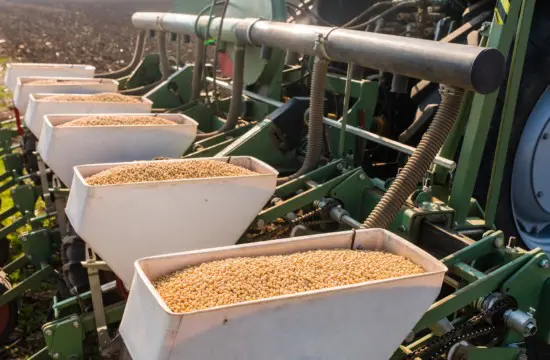If there’s a buzz word in sustainable agriculture, it’s cover crops. Ten years ago, the seeding options for cover crops were primarily limited to drill, but the recent explosion in cover crops has led to a variety of seeding innovations, each with its own advantages and challenges.
Many farmers are adding cover crops to their crop rotations to keep soil covered when the fields are not growing cash crops. Famers have many questions about incorporating cover crops, especially regarding the specific crops that can be used, when and how to seed, and when and how to terminate.
Nitrate losses from Iowa cropland can find its way to surface waters through surface runoff and tile drains. Studies show as much as 80 percent of these losses can occur during the winter and into spring. Many cover crops are good scavengers of nitrogen and will take up excess nitrogen and store it in plant tissues through the winter and early spring.
There are many advantages to effectively utilizing cover crops:
- Help protect soil from erosion
- Increase resilience against soil compaction
- Boost organic matter content
- Feed soil organisms
- Provide some weed control
- Produce mulch for next year’s crop
- Hold and recycle nutrients
- Produce extra forage in the fall or next spring
The United States Department of Agriculture, as well as universities, farmers and additional agricultural companies are testing cover crops to discover the economic benefit, the impact on soil health, and the best way to incorporate cover crops into different crop rotations. These rotations depend primarily on seed selection and seeding methods.
5 Ways to Seed Cover Crops
Highboy
The highboy seeding technique allows for early seeding dates that result in additional cover crop growth when compared to the drilled treatment that commonly follows corn and soybean harvest. The system is commonly used on a sprayer implement and can be used in a field with 12-foot corn, leaving the stalks undamaged.
Highboy seeders improve the accuracy of seeding rates and seed placement over aerial seeding. Corn and soybean yields are not affected by cover crops planted before harvest.
Drilling
If you’re going in after wheat harvest to seed cover crops, a drill is a great option. Seed can be established early enough to have time for sufficient growth before winter sets in. For best growth, most seeds should have at least four weeks to grow before the first frost.
Drilling is considered one of the best and most accurate ways to successfully seed cover crops. Studies show cover crops planted with a no-till drill often result in a better stand, which maximizes cover crop benefits. With accurate metering, distribution, depth, spacing, and placement of seed, no-till drills offer uniform seed placement and excellent seed-to-soil contact, which leads to a high cover crop establishment rate.
Cover crops are typically drilled immediately after the cash crop is harvested. No-till drills, often used in conservation tillage systems, are designed to plant directly into heavy crop residue.
Broadcast
Cover crops can be broadcast onto a field, followed by a light tillage pass, or seeds can be spread and incorporated with a seeder mounted directly on the vertical tillage implement. No matter the method, shallow incorporation after broadcast seeding helps improve cover crop stands. Broadcast seeders may be mounted to ATVs, tractors or other implements to help cover large areas of ground.
Hand-broadcast seeding is a great way to establish small plots to try seeding cover crops at different times or to observe how different species perform. This method is used in a Conservation Innovation Grant project funded by the Iowa Cover Crop Working Group and the Natural Resources Conservation Service, which evaluates the impacts on soil and water quality.
Precision Planting
Precision planting is a great way to maintain consistent seed spacing and depth control to ensure a successful stand. Planting occurs after the existing crop is harvested.
Planters require 10-50 percent less seed than other methods, as seeds are individually metered and placed into the ground. With precise seed placement, planters offer great seed-to-soil contact, especially for cover crop seed mixes, allowing for faster germination and establishment than other seeding methods.
Aerial
A big advantage of aerial seeding of cover crops is that more acres can be seeded in less time than with ground equipment. Aerial application allows seeding to be done when it is physically challenging to use ground equipment, such as when crops are present or the soil is too wet for regular equipment.
Seeding germination and growth of cover crops can begin before the existing crop has been harvested. This is especially important in areas where there is a very small window of opportunity between crop harvest and the end of the growing season. Waiting to seed a cover crop until after crop harvest may result in poor stand establishment due to cold temperatures or moisture.
Farmers are Resources
Using cover crops may reduce the total energy demands of the farm. Capturing nutrients that would be lost to leaching results in the possibility of reducing the farm’s requirement for high energy inputs.
Like most farm management decisions, timing is a critical concern for cover crop management. Producers must plant early enough in the fall to allow for good establishment before winter, but also must kill winter hardy cover crops soon enough to prevent yield losses in the following crop.
The Midwest Cover Crop Council (MCCC) offers a cover crop decision system, a web-based tool to help farmers select cover crops to include in field crop and vegetable rotations. The tool can be found here.
With field days and workshops, Iowa farmers strive to help other farmers find the answers to these questions. Some producers are seasoned veterans, while others are just starting to experiment. But the fact remains from year to year; cover crops have serious momentum.


